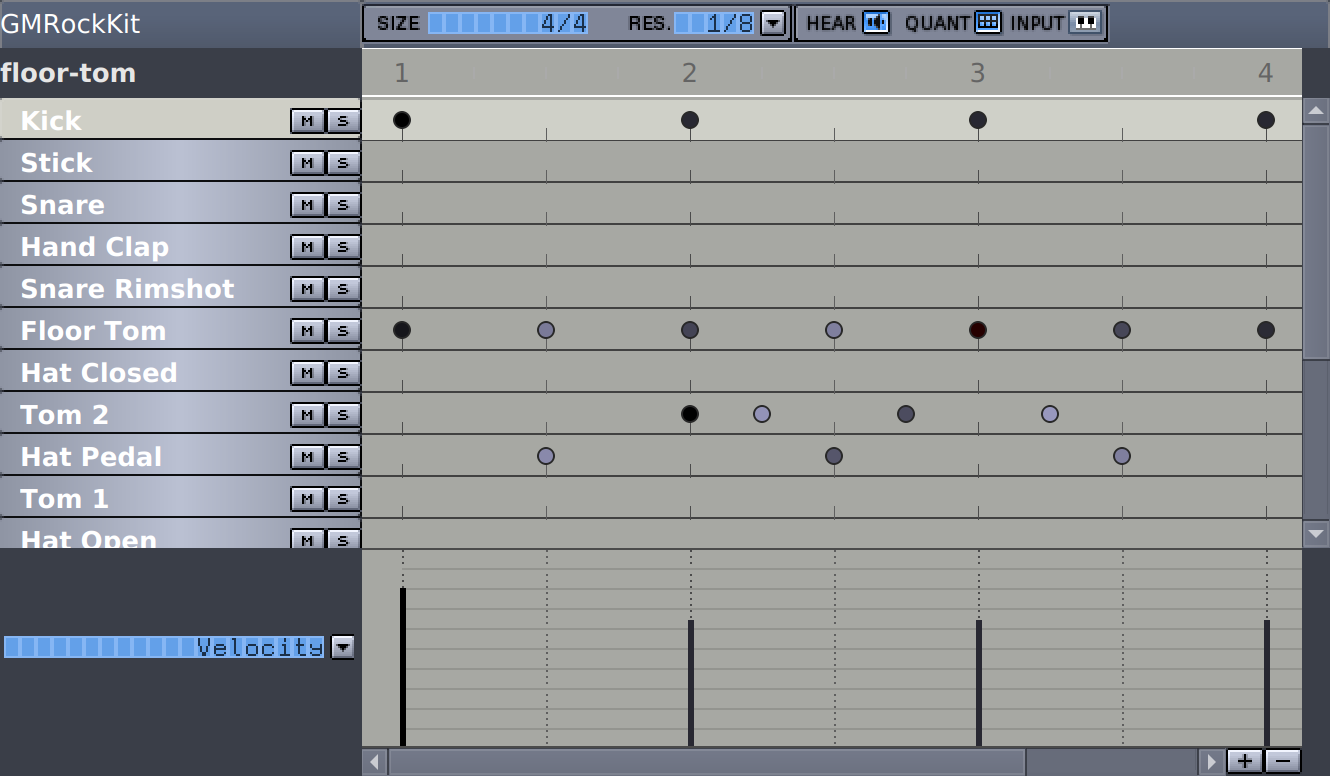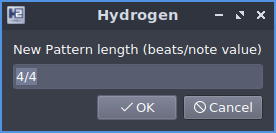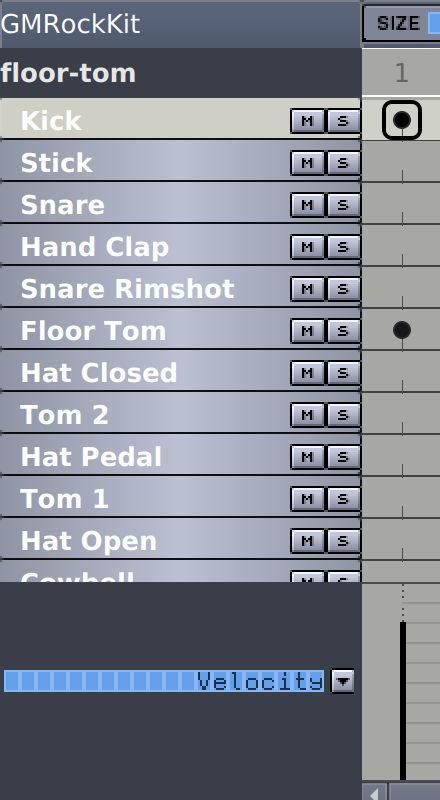Table of Contents
This is where it all happens, this is where you can make music :-)
The Pattern Editor
allows you to create and modify the pattern selected in the Sidebar of the Song Editor by adding/removing notes and tuning
a number of per-note properties, like velocity and pan.
The Pattern Editor
can be used in two modes: as Drumkit Editor or as Piano Roll Editor. You can switch between these
two by clicking the
 button (located on the top-right of the Pattern Editor).
button (located on the top-right of the Pattern Editor).
![[Note]](../img/admonitions/note.svg) | Note |
|---|---|
If you are editing a pattern in Single Pattern mode you will always hear the pattern you are editing when you playback is rolling. If you are working in Stacked Pattern mode you will hear the active pattern(s), not necessarily the pattern you are currently editing. The active patterns have a small triangle next to the pattern name in the Song Editor. (see Single Pattern and Stacked mode for details). |
The top part of the Pattern Editor contains a number of controls applying to both the Drumkit Editor and the Piano Roll Editor:
 : lets you choose the length of the pattern (in note values).
: lets you choose the length of the pattern (in note values).
It will open a dialog to enter the new size as text, in the standard music fractional notation:
Type / to separate numerator and denominator.
If you enter just the numerator (e.g.
4), the current denominator will be assumed. You can enter a decimal numerator (e.g.4.5/4) but since Hydrogen resolution is limited, some values are not supported and will be approximated.Note Hydrogen supports (only) the following denominators:
1,2,3,4,6,8,12,16,24,32,48,64,96, and192because these are the factors of the maximum resolution (192 ticks per whole note). You can use unsupported denominators, but the size will be approximated almost all the times, hence a warning icon will appear: : this is the current grid resolution (
: this is the current grid resolution (1/4through1/64with triplet-based resolutions marked as1/8T).Note If you are working with a resolution of
1/16you can't go back to8and remove an upbeat 16th note. On the other hand if you are working with a resolution of8and you try to insert a note in the middle of two bars (looking for a16bars precision), notes will be placed in the previous or in the following 8th bar. This constraint can be removed if you disable the whole grid resolution (chooseofffrom the grid resolution LCD control). Now you'll be able to place notes wherever you prefer. : when enabled Hydrogen
will play back samples as they are being added to the pattern (even if transport is not rolling).
: when enabled Hydrogen
will play back samples as they are being added to the pattern (even if transport is not rolling).
Note When disabled you will still hear the preview sound when clicking on the instrument name in the Sidebar. Be sure to click at the left-most position - where the preview is silent - in case you don't want to get disturbed.
 : enables/disables quantization.
When enabled, beats recorded from MIDI or from the
virtual keyboard will automatically respect the grid
resolution currently applied, just like notes inserted by
clicking.
: enables/disables quantization.
When enabled, beats recorded from MIDI or from the
virtual keyboard will automatically respect the grid
resolution currently applied, just like notes inserted by
clicking.  /
/  : switches between Drumkit Editor and Piano Roll Editor.
: switches between Drumkit Editor and Piano Roll Editor.
The section on the left shows you what drumkit is currently selected (GMRockKit by default) and below that you can see the instruments that are part of this kit.
Left-clicking the box containing the instrument name will play back a sample of the instrument. Which layer will be select depends on the horizontal position of the mouse click representing zero velocity to the left and maximum velocity to the right. In addition, each instrument has its own set of features that are accessible by right-clicking the instrument. From the context menu that pops up you can select.
Delete notes: removes all notes for this instrument in this pattern.
Fill notes: this allows you to fill up the pattern with notes for the selected instrument.
Note Depending on the choice you make (
fill all,fill 1/2,fill 1/4...) notes will be placed at all, 1/2, 1/4, etc of the note positions that are allowed by the grid setting. So be careful not to mix up the 'musical' 1/2-note and the 'fill 1/2' note.Randomize velocity: automatically apply a pseudo-random velocity to each note of that instrument in the pattern.
Note The more velocity you set on the instrument, the more Hydrogen will hit “hard” on that instrument when played.
Select notes: will select all the notes played on this instrument in the current pattern. They can then be copied, moved etc. in the Pattern Editor main area.
Edit all patterns: this section of the menu has actions which operate on notes played by the instrument in all the patterns of the song.
Cut notes: remove all notes played on this instrument, in all patterns, and keep them in the clipboard.
Copy notes: copy all notes played on this instrument, in all patterns, to the clipboard.
Paste notes : paste a multi-pattern selection from the clipboard to this instrument.
Delete notes: delete all the notes associated with this instrument, without affecting the clipboard.
Tip These can be used together to change the instrumentation of a song, entirely replacing one instrument with another by just copy and pasting the notes to a new instrument.
Instrument: this section of the menu has actions which operate on the instrument as a whole:
Rename instrument: change the name of the instrument.
Delete Instrument: well, deletes the instrument ;-)
The
 button mutes the instrument and
button mutes the instrument and
 solos it.
solos it.
The order of the instruments can be rearranged by simply dragging an instrument up/down in the list and dropping it on a new position within the drumkit. Doing so will not change the sequence of notes you have created for that instrument, nor will it change anything about the song or pattern you are working on.
![[Warning]](../img/admonitions/warning.svg) | Warning |
|---|---|
It will however, have an impact on the MIDI note mapping. |
![[Warning]](../img/admonitions/warning.svg) | Warning |
|---|---|
Rearranging the instruments will also mess up the per-instrument JACK output ports. Be sure to have your drumkit set up before starting wiring. |




![[Tip]](../img/admonitions/tip.svg)